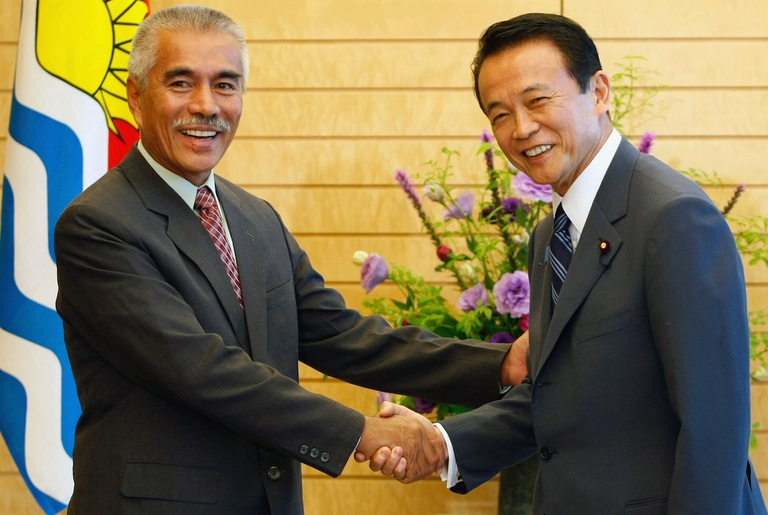
A group of experts in Tokyo suggested pouring radioactive water from Fukushima into the open sea. A marine biochemist explains the consequences of this absurd decision.
The Republic of Kiribati is one of the most affected countries by climate change. By a few decades, it could be wiped from maps.
Anote Tong is the President of the Republic of Kiribati, an archipelago inhabited by over 100,000 people that could disappear due to climate change. He came to Paris aware of the fact that the UN global conference on climate, COP 21 is a matter of life or death for his country.
The 33 Equatorial islands that are part of this small nation and are located at an average altitude of two metres above sea level could be wiped from maps. Sea level rise caused by glacier melting could completely submerge them if the average global temperature of the atmosphere keeps on rising in the next decades.
“What is important is to be able to come away from these meetings with an agreement that will be able to guarantee the survival of people, whether rich or poor. And to ensure that the next generation be guaranteed a future”, Tong explained in a video message recorded ahead of the beginning of the conference. The situation is alarming. The president of Kiribati will try to convince the governments participating in the COP 21 to adopt an agreement that can curb global warming.
In the meantime, the delegates are preparing for the worst by launching ambitious yet desperate projects: the ideas put forward include the construction of a giant floating island that could be home to as many as 30,000 people in a century. A group of Japanese engineers already visited these islands and tried to plan the project that will include the building of skyscrapers and tourist areas. But which will cost hundreds of thousands of dollars. So, in order to try to – literally – stem the problem, Tong appealed to the Netherlands, United Arab Emirates and South Korea to understand if it’s possible to build dams and how to do it or to take sand from the ocean floor to increase the average altitude of the islands.
President Anote Tong:”The biggest challenge is to assure that the next generation can be guaranteed a future” #COP21 https://t.co/kQmgQdfSFA
— COP21 – Paris 2015 (@COP21) 3 Dicembre 2015
“I’m sure you think I’m crazy – he explained to the AFP agency at the end of the conference – but we’ve got a crazy situation. I don’t think we’ve other possibilities for us”. Actually, there is one. The most dramatic and sad, yet the one that most of the Kiribati people are increasingly taking into account: leaving their homeland. A survey conducted on almost 7,000 people living in this Micronesian republic along with people of two countries particularly threatened by climate change, Nauru and Tuvalu, was presented at COP21 on 2December. Results are disarming: 70% of the families libving in these islands state that they’re ready to escape.
The same survey (carried out by the UN Economic and Social Commission for Asia and the Pacific and the UN Institute for the Environment) reveals that just half the local population has the financial resources to migrate. Many citizens are modest fishermen who will be trapped in the middle of the ocean.
“We need to train our people – Tong adds – and to get them qualified according to international standards so that if they choose to migrate they can do so today”. That’s why the Republic of Kiribati already bought a plot of farming land of 2,000 hectares in the Fiji Islands. For now, this is used to supply food the inhabitants require. In the future, this could be a new country for Kiribatians.
Siamo anche su WhatsApp. Segui il canale ufficiale LifeGate per restare aggiornata, aggiornato sulle ultime notizie e sulle nostre attività.
![]()
Quest'opera è distribuita con Licenza Creative Commons Attribuzione - Non commerciale - Non opere derivate 4.0 Internazionale.
A group of experts in Tokyo suggested pouring radioactive water from Fukushima into the open sea. A marine biochemist explains the consequences of this absurd decision.
The decline in grey and humpback whales in the Pacific and Atlantic Oceans has been traced to food shortages caused by rising ocean temperatures.
The United Nations has launched a major international alliance for ocean science, undertaking a mission close to all our hearts.
The cargo ship that ran aground off the coast of Mauritius on 25 July, causing incalculable damage, has split in two and its captain has been arrested.
The largest coral reef in the world is severely threatened by climate change, but researchers are developing strategies that could contribute to saving the Great Barrier Reef.
Seychelles have extended its marine protected area, which now covers over 400,000 square kilometres, an area larger than Germany.
Norwegian oil giant Equinor had pulled out of drilling for oil in the Great Australian Bight, one of the country’s most uncontaminated areas. A victory for activists and surfers who are now campaigning for the area to be protected forever.
30 per cent of the planet needs to be protected to stop precipitous species decline. The UN has set out its aims for the the COP15 on biodiversity scheduled for Kunming, China in October.
Ocean warming has risen to record highs over the last five years: just in 2019 the heat released into the world’s oceans was equivalent to that of 5-6 atomic bombs per second. The culprit, no doubt, is climate change.








